Auschwitz before Auschwitz: Unpublished photos show the Jewish community on the brink of the Holocaust
The Oświęcim Jewish Museum has acquired negatives discovered in 2020 that reveal the daily life of the residents of the Polish city at the beginning of the Nazi occupation

When a Polish domestic worker discovered a dusty envelope inscribed “Poland II” among old personal papers in a house in Brunswick, Germany, whose owner had died, in 2020 she was not yet aware of the significance of her find. She knew that the 140 negatives inside the envelope had historical value, but not that they would become the first visual record of the beginning of the Nazi occupation of the Polish town of Oświęcim, which was called Auschwitz by the Germans. The snapshots show the day-to-day life of the Jewish community under the control of the Third Reich, prior to the construction of the largest concentration and extermination camp of the Holocaust, which began operating in June 1940 and where more than one million people perished.
“They are a unique document. Not only of the German occupation of Oświęcim and the crimes committed, but, above all, of a historical trace that shows the Jewish community on the brink of the Holocaust,” Artur Szyndler, a historian and chief curator of the Oświęcim Jewish Museum, the institution that acquired the photographs late last year, tells EL PAÍS. The photographs were owned by Nazi doctor Hermann Barmeyer, who lived with his family in Oświęcim between 1939 and 1940. Barmeyer himself features in one them, wearing his uniform and eating with his family with a portrait of Adolf Hitler in the background. “They were probably taken by one of the Barmeyers or by a German soldier at the family’s request. The quality of the photographs shows that they were not taken by a professional,” Szyndler explains.

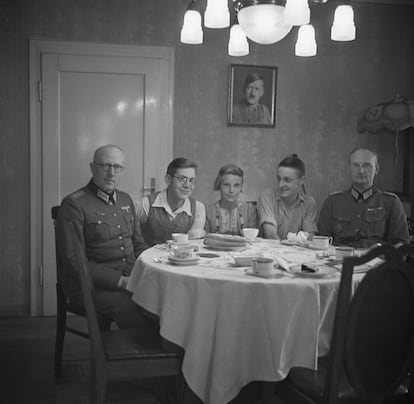


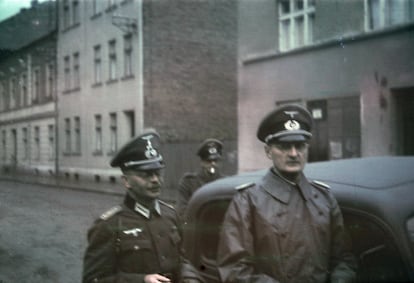
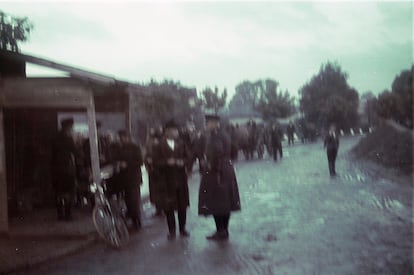
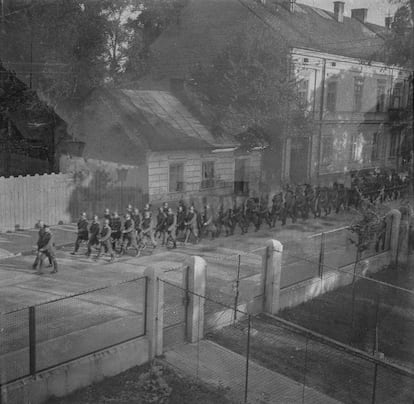
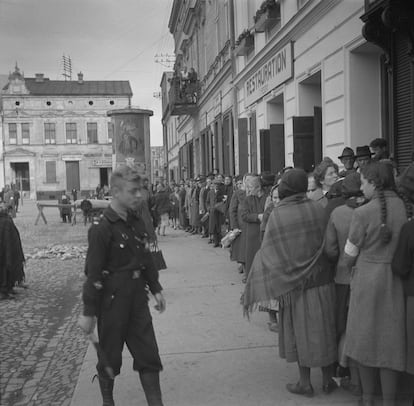
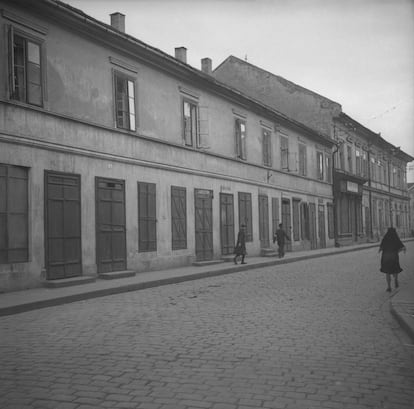
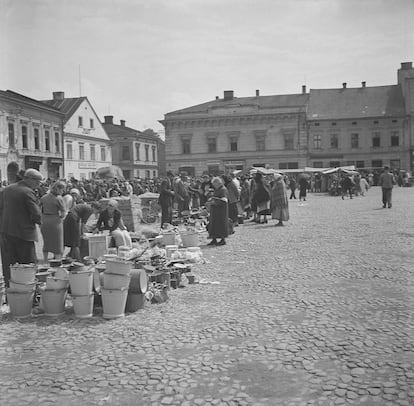

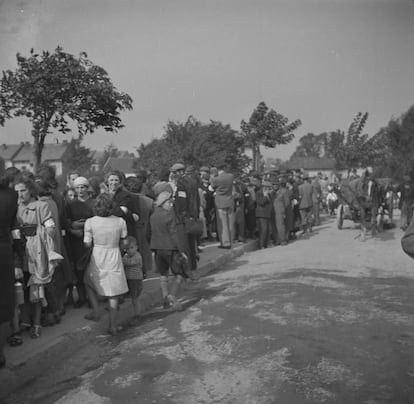

Some of the images are blurred or out of focus, but their true value is not artistic: they are a document of a turning point in the history of World War II. Several of the photographs show Jewish boys and men staring at the camera, with their arms crossed or their hands in their pockets. They wear an armband on their left arm with the Star of David on a white background, the identifying badge they were forced to wear. Later they had to carry special identification cards, stamps on documents, or markings on their clothing.
“In the Katowice district, of which Oświęcim was a part, the obligation to wear white bands on the left shoulder with the word jude (Jew) was introduced from November 1939. The following summer this was replaced by a Star of David with a white background on the left breast. In turn, from December 21, 1939, in the entire province of Silesia [to which Auschwitz also belongs], Jews over the age of 10 were required to wear a white band with the Star of David,” Szyndler summarizes. Does that mean that the photographs correspond to the latter period? “We don’t know the exact date, but in my opinion, they are from the first months of 1940,″ replies the historian.

The photos also show the Jewish community, mainly women and children, standing in long lines in the historic Market Square or in other streets of the city, under the surveillance of the SS. They may be queuing to enter the city center — special passes were required — or waiting to collect food rations. It equally might have been some kind of search operation by the occupying authorities, Szyndler hypothesizes. “Further research is needed to obtain more precise information.”
In addition to depicting the Jewish population subjected by German forces, the negatives show the main streets and monuments in the city. One is the first color image of Oświęcim on record. It shows the bridge over the Soła River and the city’s castle, built in the early 16th century, which during the war served as the headquarters of the occupying forces. Others show Jagiełłły Street (which was named by the Germans after Hermann Göring during the war), one of the most important streets in the town and which led to what would later become the Auschwitz-Birkenau concentration camp.
On Jagiełłły Street itself the Salesian complex can be seen, consisting of the school, church, and monastery, destroyed in the Polish-Swedish War (1600-1623) and rebuilt in the early 20th century, as well as the town hall. The negatives include shots of the towns of Będzin, Bielsko, Krakow, Rajsko, and Sosnowiec, but most are unidentified.
The first Jews settled in Oświęcim in the 16th century; they called it Oshpitzin, which in Yiddish means “guests.” By the beginning of the 20th century, they already constituted around 60% of the town’s population of 12,000. The community disappeared during the 1941 deportations to the ghettos of Będzin, Chrzanów, and Sosnowiec. Those who survived until 1943 were sent to Auschwitz-Birkenau, where most were killed in the gas chambers. “Only a handful survived the Holocaust,” Szyndler recounts.

One of the first measures the Nazis took when they invaded the city in September 1939 was to close Jewish businesses and stores or place them under the administration of a German appointee. On the night of November 29-30, 1939, Hitler’s armed forces burned the Great Synagogue, built in 1879 and the remnants of which have formed the Oświęcim Memorial Park since 2022.
Forced labor was a regular practice to which between 120 and 200 Jews were subjected daily. From the beginning of May 1940 until June, at the request of the future commandant of Auschwitz, Rudolf Höss, the mayor of the city additionally forced the council of elders of the Jewish community to assign some 250-300 men to work each day. They were ordered to clear the area of the former barracks where the camp was to be located, on the outskirts of the city.
The Oświęcim Jewish Museum, located in the center of the old town, has not yet prepared an exhibition to display the photographs but it has posted some of them on its Facebook account. The museum’s intention first is to “properly develop” the material from a historical point of view. “We hope to identify the other locations in the photos. We have already asked other researchers, historians, and museums for help,” Szyndler says.
In the case of the people in the images, it will be “extremely difficult to identify them beyond the members of the Barmeyer family.” The museum has asked for help in this task from networking groups dealing with Jewish history.

Sign up for our weekly newsletter to get more English-language news coverage from EL PAÍS USA Edition
Tu suscripción se está usando en otro dispositivo
¿Quieres añadir otro usuario a tu suscripción?
Si continúas leyendo en este dispositivo, no se podrá leer en el otro.
FlechaTu suscripción se está usando en otro dispositivo y solo puedes acceder a EL PAÍS desde un dispositivo a la vez.
Si quieres compartir tu cuenta, cambia tu suscripción a la modalidad Premium, así podrás añadir otro usuario. Cada uno accederá con su propia cuenta de email, lo que os permitirá personalizar vuestra experiencia en EL PAÍS.
¿Tienes una suscripción de empresa? Accede aquí para contratar más cuentas.
En el caso de no saber quién está usando tu cuenta, te recomendamos cambiar tu contraseña aquí.
Si decides continuar compartiendo tu cuenta, este mensaje se mostrará en tu dispositivo y en el de la otra persona que está usando tu cuenta de forma indefinida, afectando a tu experiencia de lectura. Puedes consultar aquí los términos y condiciones de la suscripción digital.
More information
Archived In
Últimas noticias
Maduro counterattacks Trump with rhetoric and announces downing of nine drug trafficking aircraft
‘Ecce Homo’: The miraculous disaster that made a small Spanish town famous
Return to sex testing at the Olympics: IOC edges closer to banning transgender women
Trump escalates conflict with Venezuela with the start of covert operations
Most viewed
- Sinaloa Cartel war is taking its toll on Los Chapitos
- Oona Chaplin: ‘I told James Cameron that I was living in a treehouse and starting a permaculture project with a friend’
- Reinhard Genzel, Nobel laureate in physics: ‘One-minute videos will never give you the truth’
- Why the price of coffee has skyrocketed: from Brazilian plantations to specialty coffee houses
- Silver prices are going crazy: This is what’s fueling the rally











































